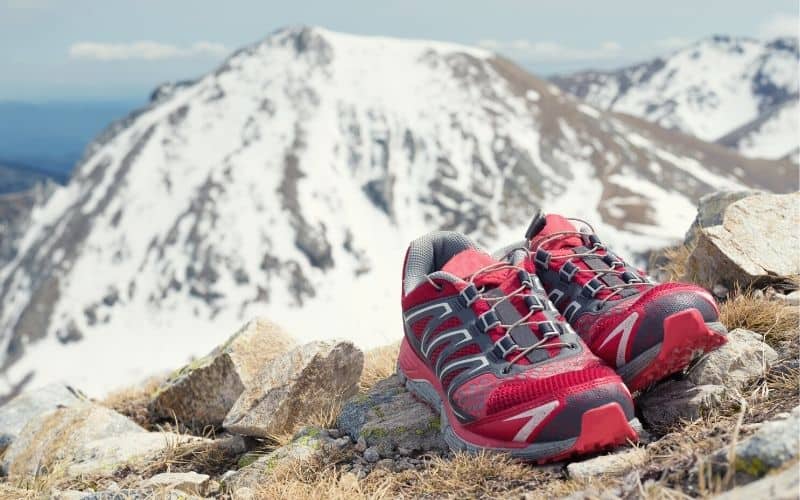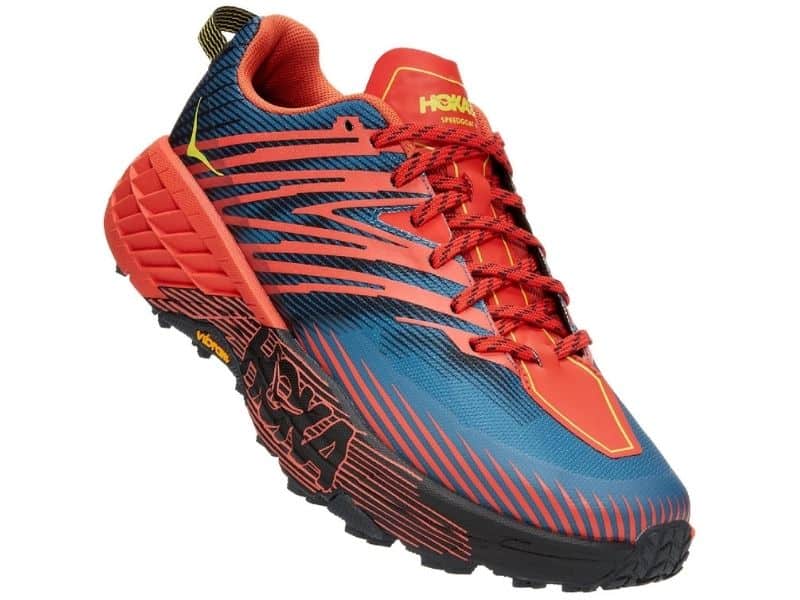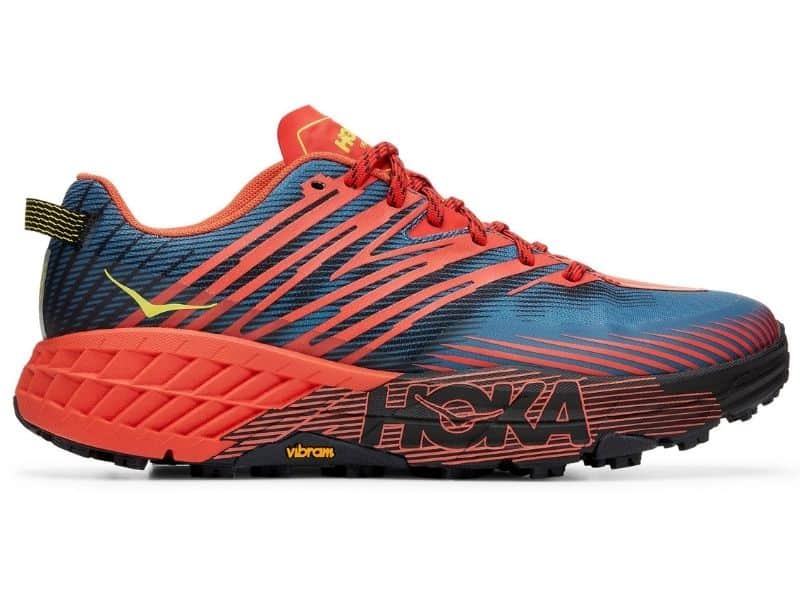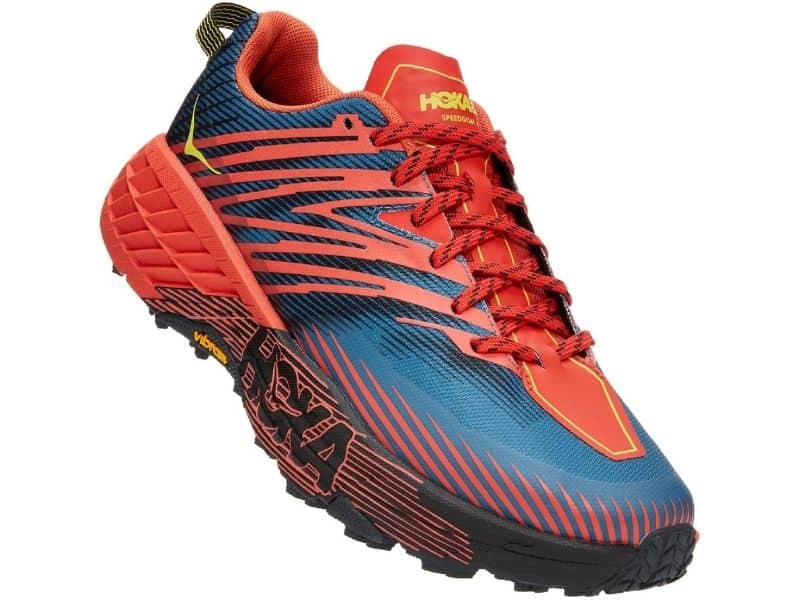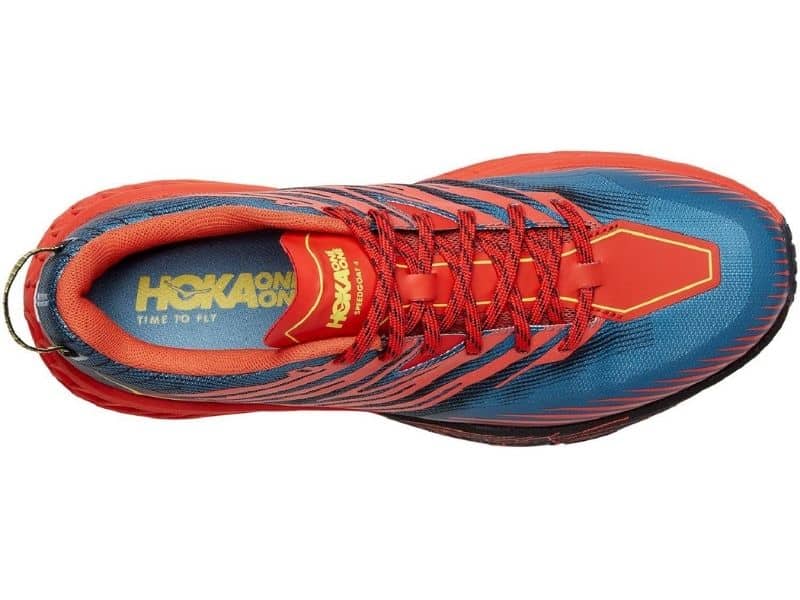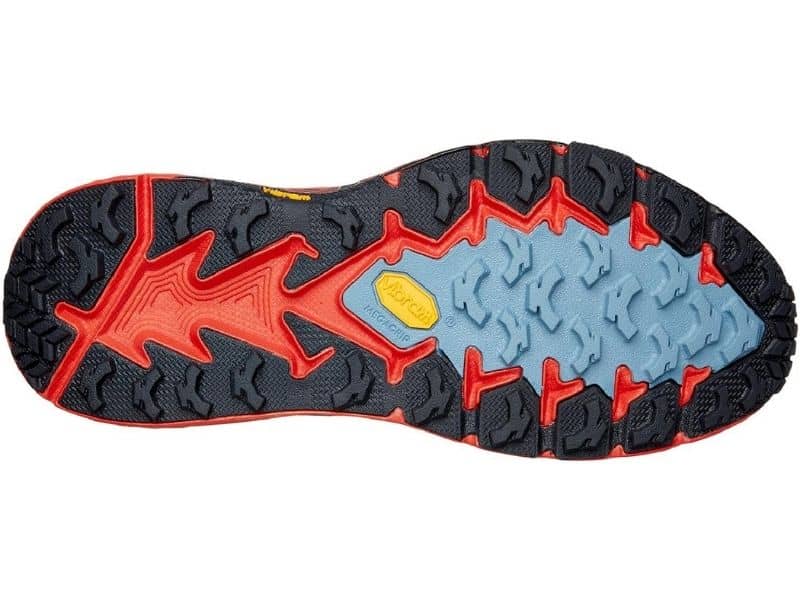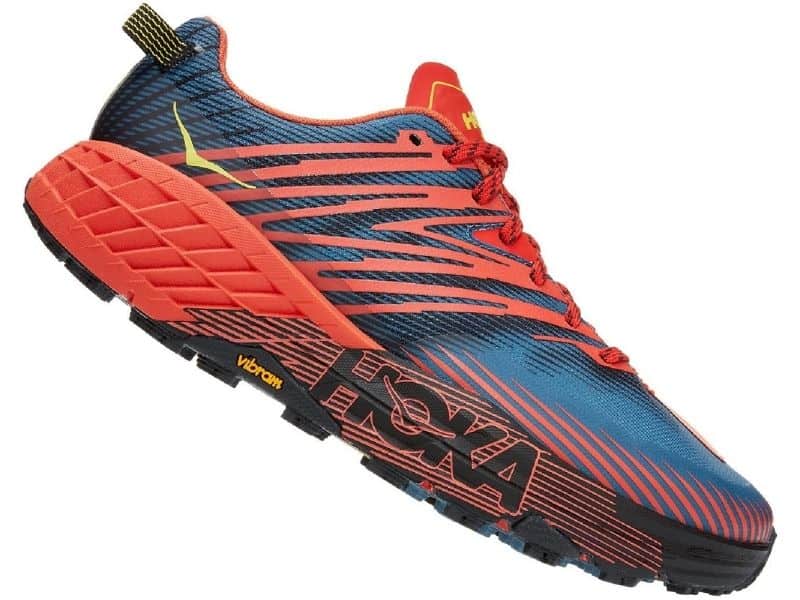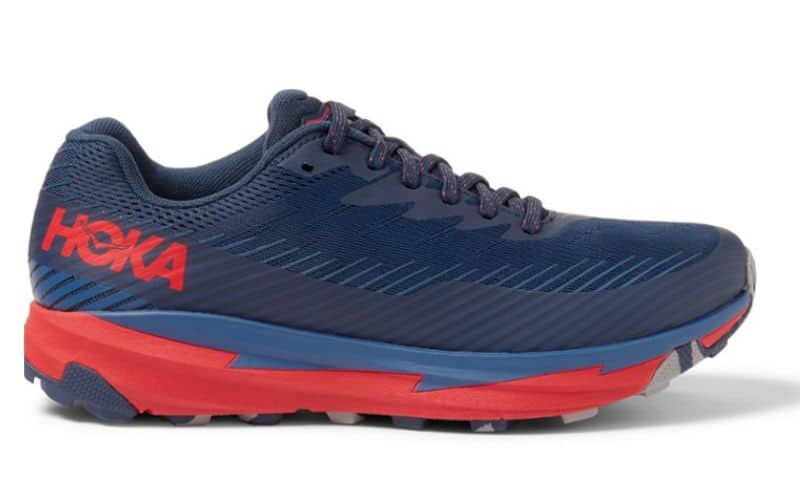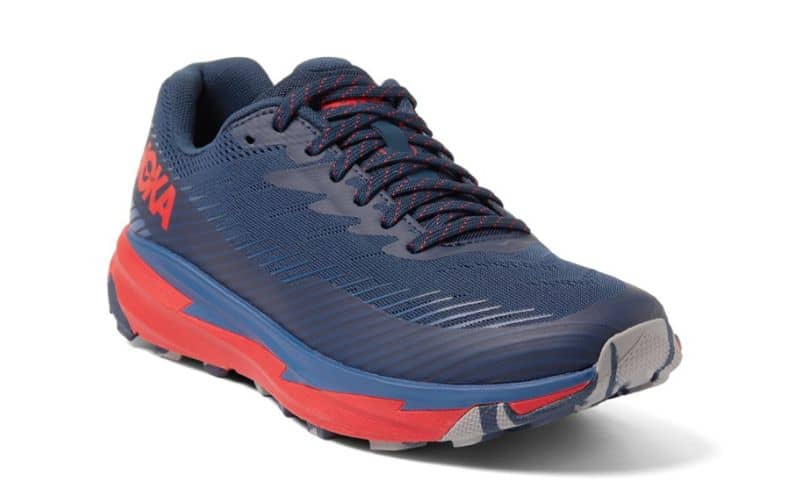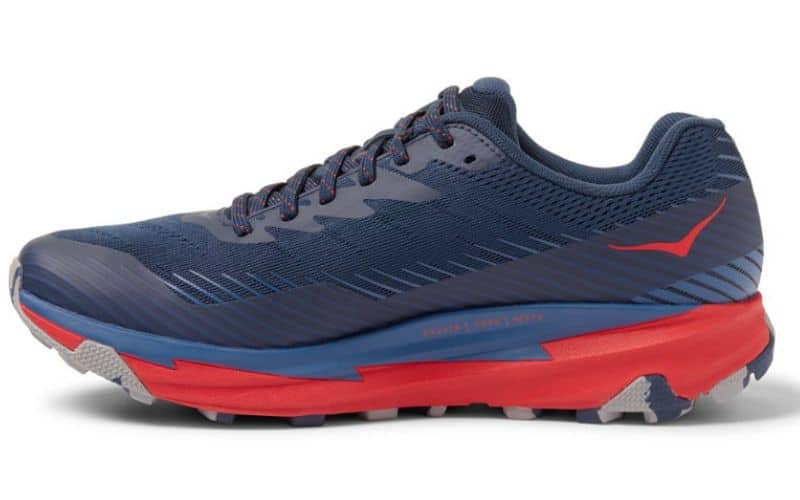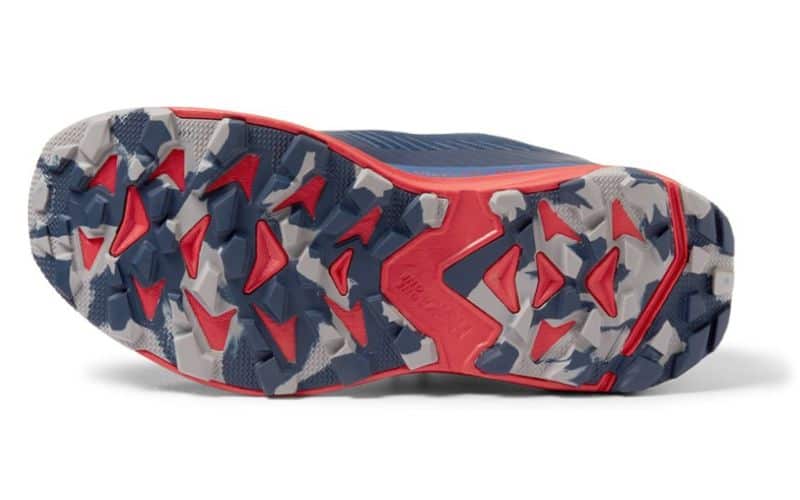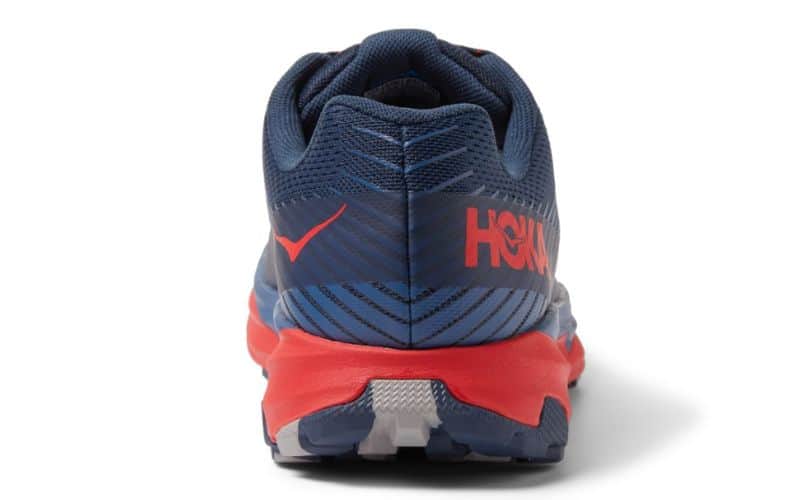Keeping your feet happy is the most important part of having a good time on any hiking adventure.
While most people wear boots for hiking, we’re here to tell you that’s not the only way. To our mind, hiking in trail running shoes is better than hiking in boots. Hiking shoes are lighter and breathe better than hiking boots. And, if your feet can’t breathe enough while you’re out on a longer hike, you’ll likely return with a blister or two in addition to other aches and pains.
Using trail runners on your next hiking trip will allow you to move faster and in comfort. That seems like a win-win situation to us!
In this guide, we’ll explain everything you need to know about all the top trail runners out there. We’ll give you detailed buying advice to help you find the best shoes for your needs, budget, and adventure type and also show you our 11 favorites.
Whether you’re planning to thru-hike the Appalachian Trail or getting into running on trails, there’s something for everyone on this list!
Table of Contents
Best Trail Runners for Hiking by Category
Ultralight: Hoka One One Torrent 2, Topo Athletic MTN Racer 2, Arc’teryx Norvan VT 2
Zero-Drop: Altra Olympus 4.0, Altra Lone Peak 6
High-Drop: Hoka One One Speedgoat 4, Salomon Speedcross, Nike Pegasus 3, La Sportiva Jackal
Budget: Salomon Sense Ride 4, Brooks Divide 2, Nike Pegasus 3
Editor’s Choice
Hoka One One Speedgoat 4
In our opinion, the Hoka One One Speedgoat 4 is the best trail running shoe for hiking. For this reason, we’ve given this cushy shoe this year’s Editor’s Choice award. This is a versatile shoe that can handle anything, from rough terrain to smooth, packed dirt, and even paved paths.
These lightweight trail runners have burly lugs that offer great grip on soft ground. They have loads of cushioning, too. Some shoes with this much stack height feel sloppy over technical terrain, but not these. The Speedgoats offer exceptional stability too, even compared to shoes with a lot less stack.
With these shoes, your feet won’t get as tired. You’ll be able to hike all day in them without that sore bottom of the foot feeling you get after a long day on the trails. They also come in standard width and wide. We like them in the wider size when we’re facing long days on the trails so our feet have room to expand.
The Speedgoat 4 are also durable. We’ve used them on long thru-hikes. They lasted much longer than we expected and much longer than some other trail running shoes.
Bottom Line: With loads of cushioning, great stability, and surprising durability, Hoka One One has a winner with the Speedgoats.
At a Glance: Quick Recommendations
-
Editor’s Choice:
Hoka One One Speedgoat 4
“Ultra cushioned yet stable and nimble, the Hoka Speedgoat is our pick for the best trail running shoe for hiking.” -
Best Traction:
Salomon Speedcross 5
“This offering from Salomon has the burliest lugs out of any we tested.” -
Best Value:
Salomon Sense Ride 4
“A great value all-around trail runner with laces that never come untied.” -
Best Cushion:
Altra Olympus 4.0
“With a high stack height, zero drop, and a wide toe box, this one is stable yet ultra-comfortable.” -
Honorable Mention:
Topo Athletic MTN Racer 2
“With a wide toe box and minimal heel-to-toe drop, the Racer 2 are ideal for wider footed hikers who like a nearly barefoot feel.” -
Best for Stability:
Altra Lone Peak 6
“With zero drop and a wide toe box, these shoes are comfy right out of the box and will have your feet moving naturally and happily down the trails.” -
Premium Pick:
Arc’teryx Norvan VT 2
“These are loaded with great features, as they should be with that price tag!” -
Best Ultralight:
Hoka One One Torrent 2
“These are the lightest shoes on this list but don’t skimp on premium features either.” -
Best for Peak Bagging:
La Sportiva Jackal
“These shoes stick to rocky surfaces and have a wide enough fit for long days over varied terrains.” -
Best High-Drop:
Nike Pegasus Trail 3
“These are built for speed on flatter terrain with a high heel-to-toe drop.” -
Best Budget:
Brooks Divide 2
“These are the least expensive shoes on this list but full of premium features.”
Best Trail Running Shoes for Hiking: Our Top 11 Picks
Hoka One One Speedgoat 4
Editor’s ChoiceWeight: 1 lb. 5.6 oz. · Stack: 32 mm · Drop: 4 mm
The Hoka One One Speedgoat 4 are the best trail running shoes for hikingthat we’ve found anywhere. They have loads of cushioning to keep your feet feeling good all day long. We’ve never found another shoe that keeps our feet feeling this good for this long, and we’ve worn a lot of trail runners while hiking over the years!
Even though they have loads of foam for cushioning beneath your feet, these shoes are surprisingly stable. They handle rough, rocky terrain with ease. And, they don’t give you that “I could roll my ankle at any moment” feeling that some high-stack shoes do.
Speaking of stability, the lugs on these shoes are deep and bite into soft dirt to keep you from slipping. Plus, the Vibram soles on these shoes stick to rock very well.
Perhaps the most surprising thing about these shoes is their durability. Generally, after about 500 miles most trail runners are toast. You know it because your feet and joints hurt.But, not the Speedgoats. These shoes just keep going and keep making you feel good as you float down the trails.
PROs
- Quality outsole materials
- High stack height
- Deep lugs
- Durable
- Stable
- Come in wide size
CONs
- Pricey
- Loud Hoka colors aren’t for everyone
Bottom-Line: Simply put, the best trail running shoe for hiking of any we’ve tested.
Salomon Speedcross 5
Best TractionWeight: 1 lb. 7.2 oz. · Stack: 35 mm · Drop: 10 mm
The Salomon Speedcross 5 (check here for women’s version) are built for speed. They’ll fly over questionable terrain, keeping you upright all the while. The deep lugs and high heel-to-toe drop make you feel like you’re flying uphill. And, those lugs won’t let you slip while you’re doing just that.
These shoes are very comfortable. The uppers are completely welded. There are no stitches to uncomfortably rub on your feet all day. The heel cup also does a great job of cradling the heel so it doesn’t move in the shoe.
After several times using the Speedcross 5 in wet, muddy conditions, we’re impressed with the performance. However, we’re a bit skeptical that the antimicrobial-treated footbeds can keep something like a running shoe smelling fresh. So far we think it’s helping but suspect these will still stink eventually.
On flat surfaces and downhill, we also felt like we would fall on our faces with those 10 millimeters of drop.
PROs
- Deep lugs
- Well-cushioned
- Good toe protection
- Antimicrobial
CONs
- No rock plate
- Heavy
Bottom-Line: A burly, aggressive trail runner that’s great for hiking in suboptimal conditions.
Salomon Sense Ride 4
Best ValueWeight: 1 lb. 4.8 oz. · Stack: 32 mm · Drop: 8 mm
The Salomon Sense Ride 4 (click here for women’s version) are great for hiking in the dry, hardpacked conditions that are common out west. If you don’t have a wide foot, these are a fantastic high-value shoe ideal for hiking in all but the most extreme conditions.
This is a trail runner, no doubt. But, the lugs on this shoe aren’t too large, so these can work as mixed surface running shoes for hiking and running on varying terrain types. If you have some pavement to cover before you get to singletrack, these will work well for you.
This shoe is on the narrow side. We have wider feet, but the quick lacing system made them fit pretty well. We were able to easily tighten these shoes just enough and evenly on our feet. Still, if you have a wider foot these might not be the best pick for you. We found them to be plenty comfortable, but they did start to feel pretty tight after a long day on the trails.
PROs
- Affordable
- Well-cushioned
- Versatile
CONs
- No rock plate
- Narrow fit
Bottom-Line: The high stack height and Quicklace system make these shoes very comfortable over mixed surfaces. A winner if you have narrow feet!
Altra Olympus 4
Best CushioningWeight: 1 lb. 6 oz. · Stack: 33mm · Drop: 0mm
The Altra Olympus 4 (click here for women’s version) are some of the most expensive shoes we tested for this review. However, when you put them on the first thing you’ll notice is that they’re immediately comfortable. The wide toe box gives you space in the forefoot so your toes can splay out. This creates a wider and more stable platform for your foot as you hike.
Even though the Olympus 4 have a lot of material in the midsole, they aren’t heavy. They feel very light as you step. And, that extremely cushioned midsole keeps your feet feeling good over long days on the trails. The rubber outsole is grippy over dirt, rocks, roots, and anything else the trails throw at you.
As with all shoes, these don’t fit everyone’s feet perfectly. We recommend trying these on to make sure they fit well before taking them outside. Just because you’ve worn other Altras doesn’t mean these will fit the same. But if these do fit your feet, they sure are a very comfortable shoe!
PROs
- Quality outsole material
- Lots of cushioning
- Zero-drop
- Protects the toes
- Vegan
CONs
- Expensive
Bottom-Line: The high stack height and wide toe box on these make for an ultra-comfortable hiking experience.
Topo Athletic MTN Racer 2
Honorable MentionWeight: 1 lb. 4 oz. · Stack: 30mm · Drop: 5mm
The Topo Athletic MTN Racer 2 (click here for women’s version) is such a top-class shoe that it almost earned our Editor’s Choice award for the best trail running shoe for hiking. It didn’t quite edge out the Hoka Speedgoat, but it is still an excellent shoe for hiking. We like MTN Racer more than the Speedgoat in trail running applications, but we’re talking about shoes for hiking here.
We love the fit of the MTN Racer. The heel cup held our foot in place very well and the forefoot had plenty of room for our toes. Overall, these shoes are some of the most comfortable we tested.
And, these shoes stayed comfortable all day. They have adequate cushioning for high-mileage days. The slightly lower center of gravity feels more stable on technical terrain, too. These don’t have a rock plate or any sole protection, but the stack is just enough to make one unnecessary.
PROs
- Quality outsole material
- High stack height for comfort
- Vegan
- Made of recycled materials
- Roomy toe box
CONs
- No rock plate
- Pricey
Bottom-Line: Pricey, but supremely comfortable. Ideal for hikers who want one shoe for both hiking and trail running.
Altra Lone Peak 6
Best for StabilityWeight: 1 lb. 5 oz · Stack: 25mm · Heel to Toe Drop: 0mm
The Altra Lone Peak 6 (click here for women’s version) is in its own category in many regards. Yes, this is a trail running shoe, but it’s closer to a minimalist shoe than a hiking boot – something we can’t say about most of the other running shoes in this review.
Many hikers and trail runners think these are the best shoes out there. We think they’re an awesome shoe, but they’re so unique that it’s hard to even compare them to other models.
The zero-drop paired with the minimal yet just about adequate stack height on these shoes make you forget you’re wearing shoes at times. They’re cushioned, but you can still feel the ground and get plenty of feedback. All of this makes the Lone Peaks the best for stability. They take some getting used to, but they’re great when your feet are used to them.
PROs
- Zero-drop for stability
- Protects the toes
- Adequate cushioning
- Lighter and more secure fit than Altra Lone Peak 5
CONs
- Zero-drop isn’t for everyone
- Pricey
Bottom-Line: Zero-drop and wider toe box make it great for stability, but the natural foot shape takes some getting used to.
Arc’teryx Norvan VT 2
Premium PickWeight: 1 lb. 6.6 oz. · Stack: 25mm · Drop: 8mm
The Arc’teryx Norvan VT 2 (click here for women’s version) is the most expensive shoe we tested. However, it’s loaded with premium features that we think make it worth the hefty price tag.
These are very versatile shoes. They feel great on smooth trails but really shine on rocky and uneven terrain.
We thought they were great for rock scrambling. The rubber is very grippy, which gave us confidence while climbing from rock to rock. When we veered off-trail, they did well, too. They have plenty of protection built-in throughout, so no matter where we stepped we did it with confidence. These felt secure on our feet, and the lugs are deep enough to bite into soft terrain.
PROs
- Quality outsole materials
- Protect the toes
- Good underfoot protection
- Great grip on rock and loose terrain
CONs
- Expensive
Bottom-Line: The Norvan VT2 have an ultra-high quality outsole with good protection, but they sure are expensive!
Hoka One One Torrent 2
Best UltralightWeight: 1 lb. 2.6 oz. · Stack: 23mm · Drop: 5mm
The Hoka One One Torrent 2 is the lightest shoe in this review. However, that’s not all that’s great about this shoe. We think these are some of the best trail runners out there. They have just the right amount of stack to cushion your feet while still maintaining that stability you want from a trail runner.
The ultralight trail runners do great moving over rugged ground. The multi-directional lugs are deep enough to bite into any terrain. Even though they’re light, they don’t skimp on protection, either. The forefoot and toe sections of the uppers are reinforced with a molded overlay. This helps to protect your toes, but it also makes them much more resistant to tears in the mesh uppers.
Plus, the uppers on the Torrents are made from post-consumer waste plastic. So even when you have to buy another pair, you can feel better about it.
PROs
- Affordable
- Lightweight
- Protect the toes
- Deep lugs
CONs
- No rock plate
Bottom-Line: This is the lightest option on this list and holds its own in durability and stability.
La Sportiva Jackal
Best for Peak BaggingWeight: 1 lb. 5.2 oz. · Stack: 29mm · Heel to toe drop: 7mm
The La Sportiva Jackal (click here for women’s version) are designed for ultramarathons but they’re also great for long days hiking in the mountains.
They are one of the widest shoes that La Sportiva makes. Most models made by this brand run on the narrow side, but not the Jackal. Because your food will spread out and swell over a long day on the trails, this makes them awesome for hiking.
While more expensive than some competitors, the Jackal are among our favorites for technical trails. They provide incredible traction over slick rock and while scrambling over rocky trails or boulder fields. We think these shoes feel almost as grippy as a dedicated approach shoe.
We did find that the heel cup didn’t initially fit our heel quite perfectly, but after switching to the heel lock lacing method this wasn’t an issue anymore.
PROs
- Toe protection
- Protect the soles
- Vegan
- Great grip
CONs
- A bit pricey
- La Sportiva doesn’t fit all feet
Bottom-Line: A wider shoe with great toe protection for long days on and off the trails.
Nike Pegasus Trail 3
Best High-DropWeight: 1 lb. 6.6 oz. · Stack: 24.5mm · Drop: 9.5 mm
Nike is a relative newcomer to the world of trail shoes, but they’re now onto the third version of the Pegasus. And with the Pegasus 3 (click here for women’s version), they’ve improved on previous iterations.
This is an affordable trail runner for moderately technical trails. And, to our mind, it’s also one of the best out there for trail runs that also have some paved sections thrown in.
This isn’t the most hardcore trail shoe out there. It’s not even the best for highly technical trails that Nike makes, but is a great choice for moderate off-road conditions and hiking on mellower trails. Its high stack height and maximum cushioning also make it one of the most comfortable trail running shoes we tested.
PROs
- Affordable
- Tall lugs
- High stack height
CONs
- No rock plate
Bottom-Line: This is a good all-around trail runner for hiking local trails, though we wouldn’t take it on the Appalachian Trail or other super-technical terrain.
Brooks Divide 2
Best BudgetWeight: 1 lb. 4.6 oz. · Stack: 20mm · Drop: 8mm
The Brooks Divide 2 (click here for women’s version) is the most affordable shoe we tested for this review. The Divide is made for those who want to go on some trail runs, but don’t want to go hardcore on the rough trails just yet.
In a nutshell, these are hybrid-style, lightweight trail runners for hiking that can handle both pavement and moderate trails. While they have light cushioning, they offer good grip, are breathable enough for hikes in high temperatures, and have a nice tongue design that keeps your forefoot snug and comfortable all day.
PROs
- Affordable
- Good sole protection
- Good grip
CONs
- Minimally cushioned
Bottom-Line: This is a lightweight and affordable option that will perform well as a hiker.
How to Choose Trail Running Shoes for Hiking
Weight
The best thing about trail runners is that they weigh less than hiking boots. Generally speaking, any trail runner will be lighter than most hiking boots. Weight on your feet is very important when you’re hiking all day because you’ll be picking up your feet 1000s of times. Why would you want to lift more weight than you have to?
That being said, some trail runners are lighter than others. There is usually a trade-off between weight, cushion, and protection.
Trail running shoes that are designed for more technical terrain tend to be heavier than those that are more suited for smoother trails. Toe protection, rock plates, and other foot protection all add to the weight, though will be well worth having for some.
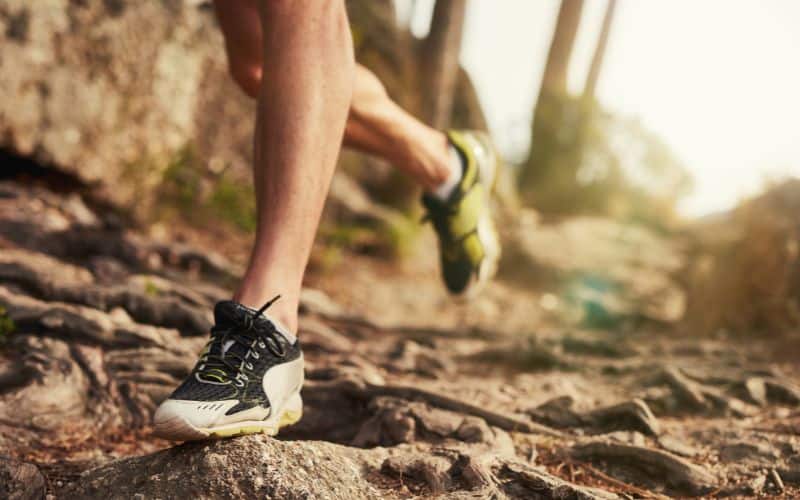
The lightest models we tested were the Hoka Torrent (1 lb 2.6 ounces) and Topo Athletic MTN Racer 2 (1 lb 4 ounces), with the Arc’teryx Norvan VT 2 (1 lb 4.2 ounces) weighing just a few ounces more.
The heaviest models we tested were the Salomon Speedcross 5 (1 lb 7.2 ounces), though the aggressive lugs, massive 35-millimeter stack height, and burly toe protection certainly contribute to their weight.
Traction & Grip
Most trail running shoes prioritize grip, but some do this more than others.
Models with deep lugs will give you a better grip on soft terrain. However, those lugs will wear down quickly if you’re hiking on a lot of rocky, rugged terrain (a common issue with the Salomon Speedcross). If you’re traveling over a lot of rocky trails with dry earth underfoot, excessively long lugs aren’t going to do you much good.
The Salomon Speedcross and Hoka Speedgoat both have 5-millimeter lugs, these are the longest of any we tested.
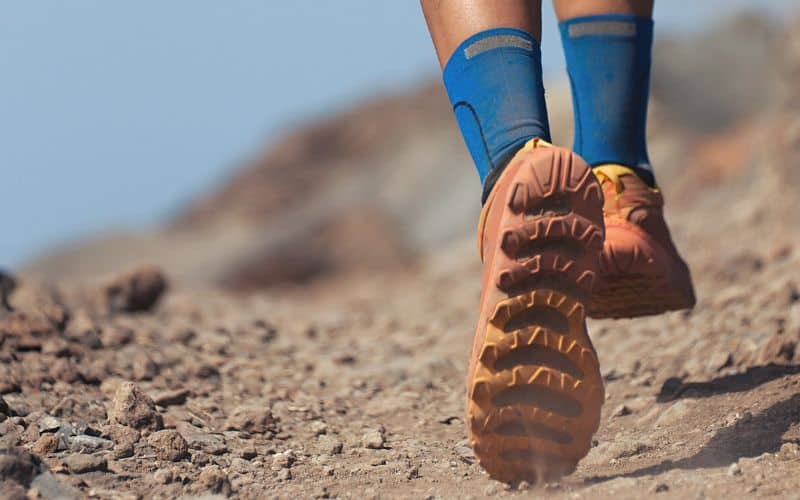
The type of rubber used in a shoe’s outsole will also contribute to its grip. If you’re going to be hiking on a lot of slick rock or rock scrambling, getting a shoe that uses a stickier rubber will help you maintain traction.
The Topo Athletic MTN Racer 2, La Sportiva Jackal, Arc’teryx Norvan VT 2, and Hoka Speedgoats all feel particularly sticky when traveling over smooth rock.
Drop
Drop, or “heel-to-toe drop]”, refers to how high your heel sits in a shoe relative to your forefoot. If a shoe has “zero-drop” then your heel won’t sit any higher than your forefoot. If a shoe has 10 millimeters of drop, that means the heel will sit 10 millimeters higher than the forefoot.
If a shoe has zero-drop, your foot will sit naturally in a piece of footwear, just as it would if you were barefoot. This is commonly considered to be the most stable position for your foot.
However, most people strike the ground with their heels first when they walk. As such, wearing minimalist shoes or zero-drop trail runners with minimal cushioning can cause foot problems stemming from “heel striking,” or the heel repeatedly hitting the ground first while walking.
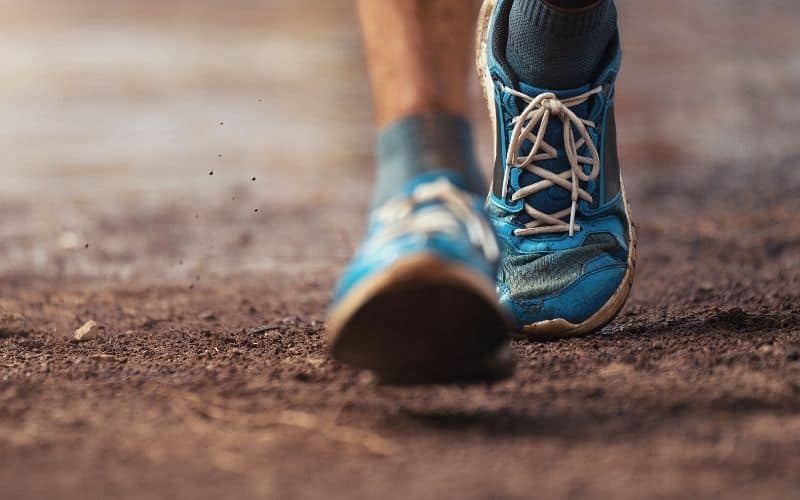
Most trail running shoes have some amount of heel-to-toe drop. The more drop a shoe has the more you’ll feel like you’re leaning forward when you’re standing. This position helps you run fast, but too much drop tends to make going downhill feel less stable for some hikers.
We tested two models with zero-drop, the Altra Lone Peak 6 and Altra Olympus 4.0.
Some people love zero-drop shoes, but they aren’t for everyone. We prefer a shoe with some drop but not too much, such as the Hoka One One Torrent 2 (5mm drop), Topo Athletic MTN Racer 2 (5mm drop), or the Hoka One One Speedgoat 4 (4mm drop).
Waterproofing
Waterproof shoes are great for hiking in snow, but in the summertime, a waterproof shoe will likely cause your feet to get too hot. And, excess heat building up in your shoes is a recipe for blisters! Every shoe we tested for this review is constructed with a breathable mesh upper.
That being said, most of the shoes in this review do come in a waterproof version. And, trail runners with a waterproof upper make for a great shoe for hiking once the snow starts to fall. Unless you’re looking for a shoe for running or hiking in the winter, we don’t recommend waterproof trail running shoes.
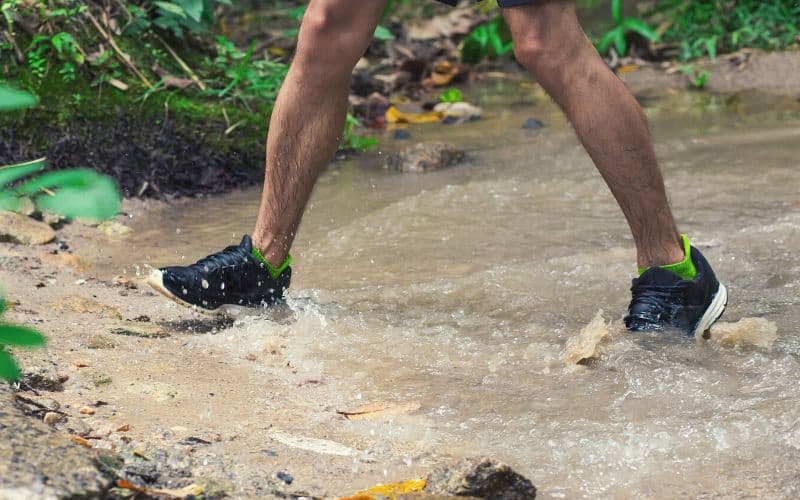
Breathability
One of the main benefits of using trail running shoes for hiking is the breathability they provide. For summer hiking, even in wet conditions, we find the breathable mesh uppers make for comfortable trail shoes that dry quickly when they get wet. And, a highly breathable trail running shoe makes a great hiking shoe because they allow your feet to breathe.
Hiking all day causes your feet to sweat, so having a breathable trail shoe is important for keeping your feet comfortable and blister-free.
Toe Protection
Most trail shoes have some sort of toe protection in the front of the shoe. This keeps the brunt of an impact away from your toes when you accidentally kick a rock or root (quite a common occurrence for most!). If you commonly hike on rocky trails and want to protect your toes we recommend getting a shoe with some toe protection.
We thought the Salomon Speedcross, La Sportiva Jackal, and Arc’teryx Norvan VT 2 stood out as having the most toe protection of all the models we tested.
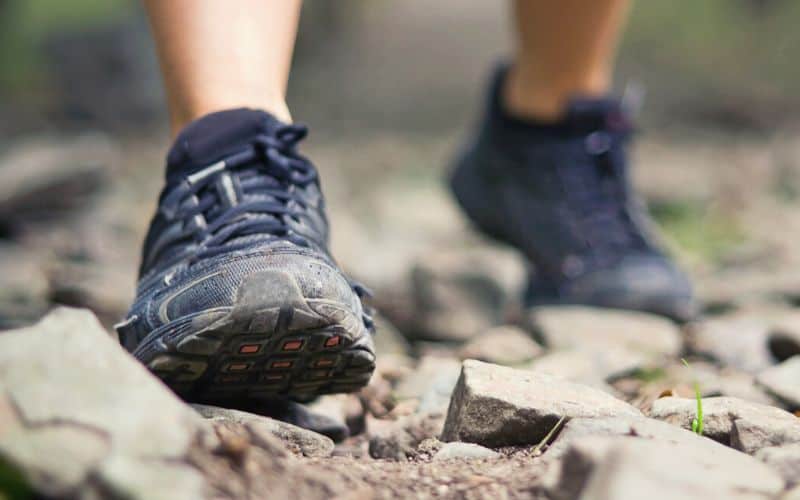
Sole Protection
If you’re out on trails, the ground is going to be rough in some areas. You’ll be stepping on rocks, roots, and who knows what else.
One of the main differences between a standard running shoe and trail running shoes is that the latter has a stiffer, more protective sole. This way, you don’t feel every rock that you step on. More importantly, sole protection can help prevent injuries to your feet.
Some trail running shoes have a rock plate to protect the sole of your foot. A rock plate is a stiff plate that shields the foot from rocks as you step. Usually, a rock plate is molded into the midsole of a shoe. However, some shoes come with a removable rock plate that looks and feels like a very stiff hard plastic insole that sits under the insole of a shoe.
Altra used to include a rock plate like this with their Lone Peaks. But they’ve since moved the rock protection into their insoles.
We found that the La Sportiva Jackal, Arc’teryx Norvan VT 2, Altra Lone Peak 6, and Brooks Divide 2 had the most substantial sole protection in the form of rock plates or rock guards built into the midsole.
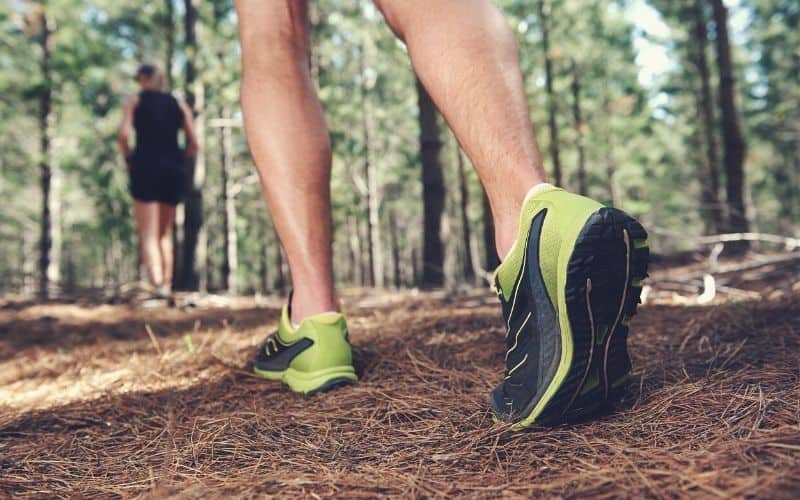
Another factor that will contribute to sole protection is the stack height of a shoe. If there is more material between you and the ground then all that extra material will protect your foot.
With higher stack height shoes like the Hoka Speedgoat 4, Salomon Speedcross 5, Salomon Sense Ride 4, Altra Olympus 4.0, and Nike Pegasus, we couldn’t feel rocks as we walked down the trails unless they were particularly sharp and large.
Best Trail Running Shoe: The Verdict
We thought the Hoka One One Speedgoats are the best trail running shoes for hiking overall. It was a tough decision though, and the Topo Athletic MTN Racer 2 was a close contender. We also think the La Sportiva Jackal is a great option for hiking, running, and scrambling, and a solid choice if you plan on using your trail runners to bag big or more technical peaks.
Did we miss your favorite? Have something else to add? Leave us a comment below!
